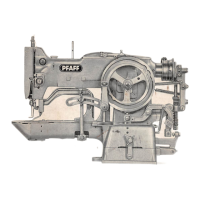The electric motor driving the machine should hove a power input of
Va
HP
(0.25
kw)
and
operate
at 1,400 r.p.m. It should be fitted with a
single-groove pulley having o
diameter
of I'Va:", or 50 mm (Order No.
99032).
This pulley develops a sewing speed of
about
1,000 s.p.m.
If, in exceptional cases, a high-speed motor operating at a speed of 2,800
r.p.m. is used, place o two-speed pulley, No.
31326,
between motor and
machine pulleys.
Electrical
information
Make sure the motor is properly connected to the power supply. When
connecting a motor to a 220/380-volt, three-phase A.C. line having a
working voltage of 380 volts (see electric meter), use the star connection.
The
delta
connection is used for lines having a working
voltage
of 220
volts. To change from one connection to the other, simply
rearrange
the
bridges on the motor terminal board, as illustrated in Figs. 57 & 58. Before
you connect a motor to another three-phase
A.C.
line (e.g.
127/220
volts),
make sure its working voltage is the same as the line voltage. The motor
pulley should turn counter-clockwise so that the belt rotates the machine
pulley at the top from the belt shifter toward the left, i.e. counter-clockwise.
To
reverse
the
direction
of
rotation,
simply
interchange
wires R
and
T.
y
2 X
u
V w
f
Fig. 57 Delta connection
A
.Y, 2 ,
X.
U V
I
w
0
1
1
R
%
^
/fTJhTf
Fig. 58
Star
connection
Connecting
the
Treadle
Chain
The longer chain serves to raise the work clamp. Attach the chain to hook
A on
lifting
lever
B
(Fig.
59),
pass it
through
the hole in the tabletop, and
connect
it
to
the
left
treodle.
The
short
chain
is
hooked
into
the
hole
ot
the
front end of starting lever C
(Fig.
60)
and attached to the right treadle. To
do
this, tilt
the
machine
back.
65

